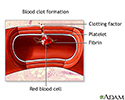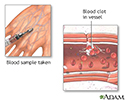Acquired platelet function defect
Acquired qualitative platelet disorders; Acquired disorders of platelet function
Acquired platelet function defects are conditions that prevent clotting elements in the blood called platelets from working as they should. The term acquired means these conditions are not present at birth.
Causes
Platelet disorders can affect the number of platelets, how well they function, or both. A platelet disorder affects normal blood clotting.
Disorders that can cause problems in platelet function include:
-
Idiopathic thrombocytopenic purpura
Idiopathic thrombocytopenic purpura
Idiopathic thrombocytopenic purpura (ITP) is a bleeding disorder in which the immune system destroys platelets, which are necessary for normal blood ...
 ImageRead Article Now Book Mark Article
ImageRead Article Now Book Mark Article -
Chronic myelogenous leukemia
Chronic myelogenous leukemia
Chronic myelogenous leukemia (CML) is cancer that starts inside bone marrow. This is the soft tissue in the center of bones that helps form all bloo...
 ImageRead Article Now Book Mark Article
ImageRead Article Now Book Mark Article -
Multiple myeloma
Multiple myeloma
Multiple myeloma is a blood cancer that starts in the plasma cells in the bone marrow. Bone marrow is the soft, spongy tissue found inside most bone...
 ImageRead Article Now Book Mark Article
ImageRead Article Now Book Mark Article -
Primary
myelofibrosis
Myelofibrosis
Myelofibrosis is a disorder of the bone marrow in which the marrow is replaced by fibrous scar tissue.
Read Article Now Book Mark Article -
Polycythemia vera
Polycythemia vera
Polycythemia vera is a bone marrow disease that leads to an abnormal increase in the number of blood cells. The red blood cells are mostly affected....
Read Article Now Book Mark Article -
Primary thrombocythemia
Primary thrombocythemia
Primary thrombocythemia is a condition in which the bone marrow produces too many platelets. Platelets are a part of the blood that aids in blood cl...
 ImageRead Article Now Book Mark Article
ImageRead Article Now Book Mark Article -
Thrombotic thrombocytopenic purpura
Thrombotic thrombocytopenic purpura
Thrombotic thrombocytopenic purpura (TTP) is a blood disorder that causes blood clots to form in small blood vessels. This leads to a low platelet c...
 ImageRead Article Now Book Mark Article
ImageRead Article Now Book Mark Article
Other causes include:
-
Kidney (renal) failure
Kidney (renal) failure
Acute kidney failure is the rapid (less than 2 days) loss of your kidneys' ability to remove waste and help balance fluids and electrolytes in your b...
 ImageRead Article Now Book Mark Article
ImageRead Article Now Book Mark Article - Medicines such as aspirin, ibuprofen, other anti-inflammatory drugs, penicillin, phenothiazines, and prednisone (after long-term use)
Symptoms
Symptoms may include any of the following:
- Heavy menstrual periods or prolonged bleeding (more than 5 days each period)
- Abnormal vaginal bleeding
- Blood in the urine
- Bleeding under the skin or into the muscles
-
Bruising
easily or pinpoint red spots on the skin
Bruising
Bleeding into the skin can occur from broken blood vessels that form tiny red dots (called petechiae). Blood also can collect under the tissue in la...
 ImageRead Article Now Book Mark Article
ImageRead Article Now Book Mark Article -
Gastrointestinal bleeding
resulting in
bloody, dark black, or tarry bowel movements
; or
vomiting blood
or material that looks like coffee grounds
Gastrointestinal bleeding
Gastrointestinal (GI) bleeding refers to any bleeding that starts in the gastrointestinal tract. Bleeding may come from any site along the GI tract, ...
 ImageRead Article Now Book Mark Article
ImageRead Article Now Book Mark ArticleBloody, dark black, or tarry bowel move...
Bloody stools often are a sign of a problem in the digestive tract. Blood in the stool may come from anywhere along your digestive tract from your m...
Read Article Now Book Mark ArticleVomiting blood
Vomiting blood is regurgitating (throwing up) contents of the stomach that contains blood. Vomited blood may appear either a bright red or dark red c...
Read Article Now Book Mark Article -
Nosebleeds
Nosebleeds
A nosebleed is loss of blood from the tissue lining the nose. Bleeding most often occurs in 1 nostril only.
 ImageRead Article Now Book Mark Article
ImageRead Article Now Book Mark Article
Exams and Tests
Tests that may done include:
-
Bleeding time
Bleeding time
Bleeding time is a medical test that measures how fast small blood vessels in the skin stop bleeding.
 ImageRead Article Now Book Mark Article
ImageRead Article Now Book Mark Article -
Platelet aggregation test
Platelet aggregation test
The platelet aggregation blood test checks how well platelets, a part of blood, clump together and cause blood to clot.
Read Article Now Book Mark Article -
Platelet count
Platelet count
A platelet count is a lab test to measure how many platelets you have in your blood. Platelets are parts of the blood that help the blood clot. The...
Read Article Now Book Mark Article -
PT
and
PTT
PT
Prothrombin time (PT) is a blood test that measures the time it takes for the liquid portion (plasma) of your blood to clot. A related blood test is ...
Read Article Now Book Mark ArticlePTT
Partial thromboplastin time (PTT) is a blood test that looks at how long it takes for blood to clot. It can help tell if you have a bleeding problem...
Read Article Now Book Mark Article
Treatment
Treatment is aimed at fixing the cause of the problem:
- Bone marrow disorders are often treated with platelet transfusions or removing platelets from the blood (platelet pheresis).
- Chemotherapy may be used to treat an underlying condition that is causing the problem.
- Platelet function defects caused by kidney failure are treated with dialysis or medicines.
- Platelet problems caused by a certain medicine are treated by stopping the drug.
Outlook (Prognosis)
Most of the time, treating the cause of the problem corrects the defect.
Possible Complications
Complications may include:
- Bleeding that does not stop easily
-
Anemia
(due to excessive bleeding)
Anemia
Anemia is a condition in which the body does not have enough healthy red blood cells. Red blood cells provide oxygen to body tissues. Different type...
 ImageRead Article Now Book Mark Article
ImageRead Article Now Book Mark Article
When to Contact a Medical Professional
Call your health care provider if:
- You have bleeding and do not know the cause
- Your symptoms get worse
- Your symptoms do not improve after you are treated for an acquired platelet function defect
Prevention
Using medicines as directed can reduce the risk of drug-related acquired platelet function defects. Treating other disorders may also reduce the risk. Some cases cannot be prevented.
References
Diz-Kucukkaya R, Lopez JA, Acquired disorders of platelet function. In: Hoffman R, Benz EJ Jr, Silberstein LE, Heslop HE, Weitz JI, Anastasi JI, eds. Hematology: Basic Principles and Practice . 6th ed. Philadelphia, PA: Elsevier Saunders; 2012:chap 132.
Jobe S, Di Paola J. Congenital and acquired disorders of platelet function. In: Kitchens CS, Kessler CM, Konkle BA, eds. Consultative Hemostasis and Thrombosis . 3rd ed. Philadelphia, PA: Elsevier Saunders; 2013:chap 10.
-
Blood clot formation - illustration
Blood clotting normally occurs when there is damage to a blood vessel. Platelets immediately begin to adhere to the cut edges of the vessel and release chemicals to attract even more platelets. A platelet plug is formed, and the external bleeding stops. Next, small molecules, called clotting factors, cause strands of blood-borne materials, called fibrin, to stick together and seal the inside of the wound. Eventually, the cut blood vessel heals and the blood clot dissolves after a few days.
Blood clot formation
illustration
-
Blood clots - illustration
Blood clots (fibrin clots) are the clumps that result when blood coagulates.
Blood clots
illustration
-
Blood clot formation - illustration
Blood clotting normally occurs when there is damage to a blood vessel. Platelets immediately begin to adhere to the cut edges of the vessel and release chemicals to attract even more platelets. A platelet plug is formed, and the external bleeding stops. Next, small molecules, called clotting factors, cause strands of blood-borne materials, called fibrin, to stick together and seal the inside of the wound. Eventually, the cut blood vessel heals and the blood clot dissolves after a few days.
Blood clot formation
illustration
-
Blood clots - illustration
Blood clots (fibrin clots) are the clumps that result when blood coagulates.
Blood clots
illustration
Review Date: 1/22/2015
Reviewed By: Rita Nanda, MD, Assistant Professor of Medicine, Section of Hematology/Oncology, University of Chicago Medicine, Chicago, IL. Review provided by VeriMed Healthcare Network. Also reviewed by David Zieve, MD, MHA, Isla Ogilvie, PhD, and the A.D.A.M. Editorial team.


